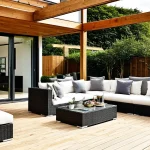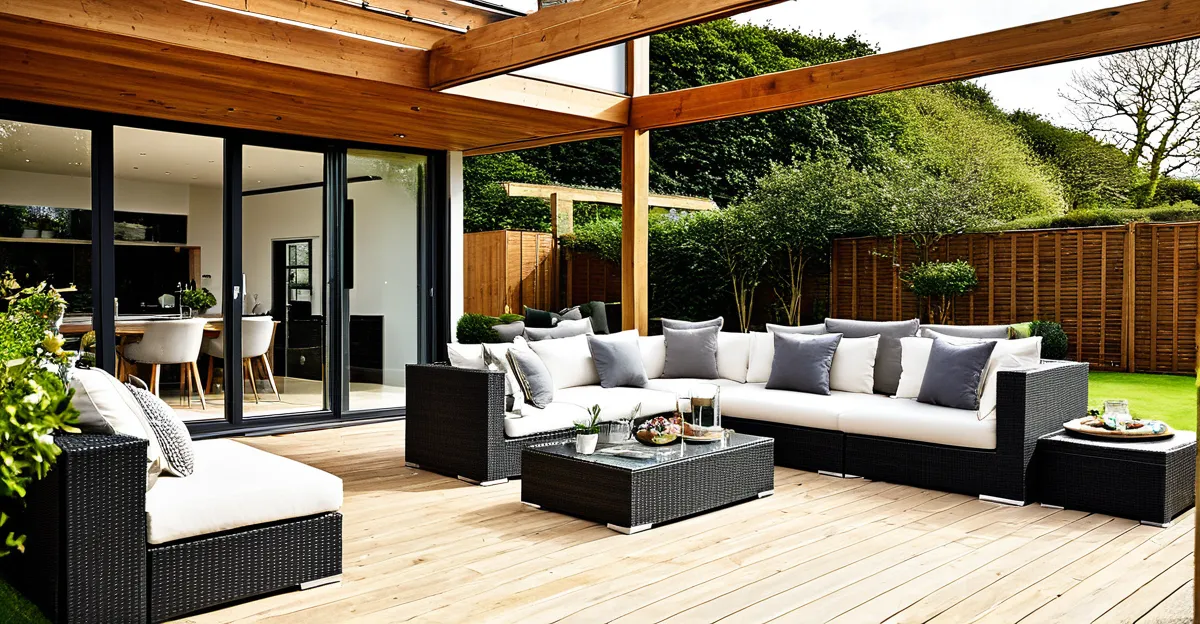Key principles for creating seamless indoor-outdoor living spaces
Creating seamless indoor-outdoor living involves a thoughtful blend of design elements that unify interior and exterior environments. At its core, seamless living requires a continuous flow between spaces. This can be achieved by aligning materials, colours, and flooring that extend from indoors to outdoors, eliminating abrupt visual or structural breaks. For example, using the same decking or tile both inside and out supports cohesion and naturally draws the eye through the threshold.
In the UK, special considerations such as weather variability and space constraints impact the approach. Properties often demand resilient solutions that can handle dampness and temperature shifts without sacrificing style. Additionally, local building regulations and planning permissions can influence how much integration is feasible. Smart choices in materials and design must balance aesthetics with practicality.
Have you seen this : How Can Innovative Designs Transform UK Home Living Spaces?
Identifying key elements like open sightlines, unified textures, and adjustable boundaries allows homeowners to enjoy a fluid transition. Emphasising indoor-outdoor design basics ensures that even with the region’s climate and typical UK home configurations, the connection feels natural and inviting year-round. Ultimately, mastering these principles creates a home where inside meets outside with elegance and ease.
Architectural and structural strategies for UK homes
Effective indoor-outdoor extension design hinges on maximising openings to create a fluid connection. Bifold doors and sliding doors are prime choices, as they fold or slide away neatly to merge inside and outside spaces without visual interruption. These doors support seamless indoor-outdoor living by expanding usable areas and enhancing natural light.
Also read : How can sustainable materials enhance UK home interiors?
Structural considerations for UK homes often involve modifying existing walls or adding extensions that comply with regional constraints. Reinforcing load-bearing walls to accommodate wide doorways or choosing lightweight materials can ease integration without compromising safety.
Planning permission UK requirements frequently influence design scope. Minor alterations like installing bifold doors may be permitted without full planning consent, but larger extensions typically require approval. It is vital to consult local regulations early in the project to avoid costly delays.
By combining strategic openings with compliant structural modifications, homeowners can achieve a harmonious blend of indoor and outdoor environments. This approach honours indoor outdoor design basics while accommodating typical UK space and planning challenges, delivering practical yet elegant solutions for year-round enjoyment.
Choosing weather-resistant materials and products
Selecting the right weatherproof materials UK is crucial for seamless indoor-outdoor living, especially given the UK’s unpredictable climate. Durable indoor-outdoor flooring like porcelain tiles, composite decking, or treated natural stone withstand moisture and temperature changes while maintaining a consistent look inside and out. These materials support the visual continuity vital to UK home integration.
Energy efficiency is an increasing priority. Installing energy-efficient glazing not only insulates homes but also reduces heat loss through large glazed openings. Double or triple-glazed doors and windows with low-emissivity coatings ensure comfort and lower energy costs, aligning with indoor outdoor design basics.
Furniture choice also plays a role: opting for weather-resistant, low-maintenance options ensures longevity and ease of care. Materials such as treated timber, powder-coated metals, or synthetic rattan resist fading and mould, supporting an attractive, durable outdoor extension.
In essence, merging high-performance materials with style fosters a practical yet elegant indoor-outdoor flow. This approach balances aesthetic continuity with resilience, addressing specific UK conditions and creating inviting, long-lasting living spaces.
Enhancing year-round usability and comfort
Seamless indoor-outdoor living thrives when spaces are comfortable throughout the year, especially in the UK’s unpredictable climate. Integrating effective heating solutions like outdoor infrared heaters or underfloor heating extends outdoor use well into cooler months. These options provide warmth without bulky equipment or visual disruption, helping maintain the fluid connection between inside and out.
Outdoor lighting plays a dual role: practical illumination and ambiance creation. Layered lighting, such as recessed floor lights, lanterns, and adjustable spotlights, ensures a welcoming atmosphere from day to night. Strategically placed lighting enhances safety while highlighting architectural features, reinforcing indoor outdoor design basics.
Creating versatile layouts supports changing needs and weather conditions. Using movable furniture and retractable awnings or pergolas offers flexibility, allowing homeowners to adapt spaces instantly. This adaptability encourages frequent use regardless of season or weather, a must for successful UK home integration.
Thus, thoughtful climate control, lighting design, and flexible arrangements work together. They make seamless indoor-outdoor living not just visually appealing but truly livable year-round, enhancing comfort and functionality in every season.
Landscaping and garden design for visual and physical flow
Achieving seamless indoor-outdoor living relies heavily on thoughtful garden landscaping UK that visually and physically connects inside and outside areas. Designing patios and decking to align with interior flooring creates a natural extension of the home. For example, consistent materials or colours used on both surfaces reinforce indoor outdoor design basics by blurring boundaries.
Incorporating raised beds and planters strategically helps merge indoor and outdoor zones. These elements introduce greenery close to interior spaces, softening transitions and enhancing the tactile connection. Selecting plants suited to UK gardens ensures year-round appeal, balancing foliage density for privacy without blocking sightlines.
Creating clear sightlines is essential. Orienting garden features, such as focal point trees or water elements, to be visible from indoor living areas invites the eye outward, encouraging movement between spaces. Pathways that flow directly from doors to garden zones also support this fluidity.
Together, these landscaping strategies ensure UK home integration is both aesthetic and practical. They reinforce the seamless connection homeowners seek, making outdoor spaces feel like an inherent part of daily living.
Furniture, decor, and styling tips for cohesion
Creating seamless indoor-outdoor living relies on selecting the right indoor-outdoor furniture UK that complements interior style while enduring external elements. Opting for weather-resistant materials like synthetic rattan, powder-coated metals, or treated timber ensures durability despite UK weather fluctuations. Furniture should be both practical and visually consistent to support UK home integration without compromising comfort.
Continuity in textiles and accessories bridges the physical gap between inside and out. Cushions, rugs, and throws made from water-resistant fabrics with colours and patterns harmonising with interior decor reinforce indoor outdoor design basics. This coordinated approach softens boundaries and helps outdoor areas feel as much a part of the home as indoor spaces.
For cohesive style, maintain a consistent colour palette across furnishings and decor. Neutral tones blended with natural greens or blues often complement garden views, enhancing fluidity. Incorporating decorative elements like plant pots, lanterns, or artwork designed for outdoor use further unifies the space.
In summary, choosing all-weather furniture paired with thoughtful textiles and a unified colour scheme ensures decor inspiration meets the practical demands of seamless indoor-outdoor living in UK homes.
Practical considerations: energy efficiency, maintenance, and budget
Balancing energy-efficient living UK with seamless indoor-outdoor integration requires careful planning. Energy efficiency hinges on using insulated glazing and doors that reduce heat loss while preserving connection to outdoor spaces. Incorporating thermal breaks in frames and quality seals further enhances insulation, lowering heating costs—a vital factor for UK homes exposed to variable weather.
Maintenance planning is equally crucial. Selecting materials and finishes that withstand moisture, dirt, and wear reduces upkeep demands. For example, composite decking and treated timber resist rot and fading, while removable cushions with washable covers simplify fabric care. Regular cleaning of glazed surfaces prevents buildup that can degrade thermal performance.
Budgeting realistically for renovations ensures smooth progress. Consider initial investment in high-quality energy-efficient living UK products alongside long-term savings from reduced heating bills. Allocating funds for professional installation, especially where planning permission UK and building regulations apply, avoids costly errors or delays.
Drainage must not be overlooked; proper water management around openings prevents damage and supports durability. Thoughtful budgeting coupled with efficient maintenance strategies enables homeowners to create lasting, comfortable spaces, blending aesthetics with practicality in their indoor-outdoor living project.







